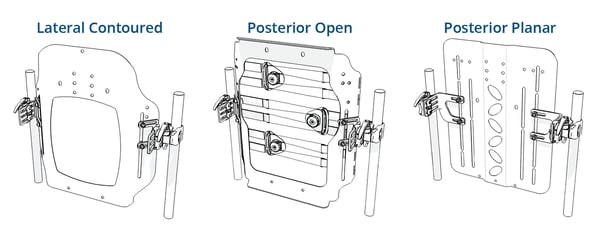Looking for more information on seating and positioning? Check out our digital, rehab-focused Wheelchair Seating & Positioning Guide here.
There are three areas to consider when choosing a back support: shape of the shell, medium, and adjustability. Today we are looking at the shape of the shell and the benefits and considerations of each style.
Shape of the Shell
Back support shells can vary in their geometry:
- Lateral Contoured Shell
- Posterior Open Shell
- Posterior Planar Shell

Lateral Contoured Shell
| Benefits | Considerations |
|
Designed to fit the anatomical shape of the user |
Contour is lateral, not on the posterior shell |
|
Various options depending on patient goals. Deep, upper thoracic or lower thoracic contours |
Look for a contoured shell with the ability to conform posteriorly |
|
Look at the shape of the upper shell for scapular cut outs if your patient is a self-propeller |
Posterior Open Shell
| Benefits | Considerations |
|
Newer concept |
May not be able to adjust for a significant lordosis
|
|
Allows for immersion posteriorly with technology that conforms to the shape of the patient |
|
|
Lightweight |
|
|
Can accommodate and/or correct for multiple reducible postural abnormalities |
Posterior Planar Shell
| Benefits | Considerations |
|
Certain planar styles can be adjustable for conforming to shape |
Most have no ability to conform to the shape of the user, resulting in the progression of postural abnormalities |
|
Flat shell allows room to attach harnesses, pelvic belts, a head support, and lateral trunk supports |
Look for the ability to adjust and contour the back support to the spine if using a planar shell |
Check back next time as we turn our focus to different back support mediums and the benefits and considerations of each.

 Stacey Mullis, OTR/ATP
Stacey Mullis, OTR/ATP
Director of Clinical Marketing
Stacey serves as Director of Clinical Marketing for Permobil. A practicing OTR for over 20 years, she has experience in school-based pediatrics, inpatient rehabilitation, long term care, and home health. With her interest in wheelchair seating and positioning, Stacey engaged the challenges of providing appropriate seating in various clinical settings. She now uses this experience to develop programs and resources to educate clinicians on the principles of seating and wheeled mobility. She is passionate about equipping clinicians and through her previous role as Director of Clinical Education with Comfort Company and now with Permobil she has taught nationally and internationally to increase therapist capacity in this specialty area. Mullis graduated from Western University in London, Ontario, Canada with a BA Linguistics and BSc Occupational Therapy. She is a member of the NCOTA, CTF Executive Board, NRRTs, RESNA, and AOTA.

